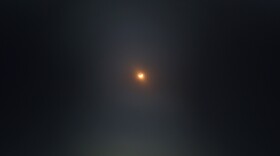For those planning to watch the Austin area’s first total solar eclipse in more than 600 years, eye safety should be the first priority — whether you're taking it in through a pair of eclipse glasses or by way of a homemade contraption.
Let me get this out of the way immediately: Never look at the sun without proper eye protection.
Eileen Bowden, an ophthalmologist with UT Health Austin’s Mitchel and Shannon Wong Eye Institute, says you want to make sure your solar eclipse viewing glasses are ISO-certified.
To do this look for an ISO marking on your glasses. For example, my glasses are marked “Meets the Requirements for ISO 12312-2:2015 Certification” while yours might only say “ISO 12312-2.” Both glasses meet the same standard but are described differently by different vendors.
Beware of counterfeits
Counterfeit eclipse glasses saturated the markets ahead of the 2017 eclipse that passed over the U. S., though the American Astronomical Society said last week that it's seen no evidence so far this year any eclipse glasses or solar viewers are unsafe.
Unfortunately, without expensive lab equipment, there is no surefire way for you to confirm whether your glasses are 100% certified, but Solar Eclipse Across America does have some ways to check to see if your glasses are not safe.
One way to be certain is to check that when wearing your glasses you should not be able to see anything in the sky except for the sun. You should also get your glasses from a reputable vendor. The eclipse is less than a month away, so the earlier you can get your glasses the better.
Maybe this isn't your first eclipse, and you're thinking you're set because you have glasses from before, but Bowden said to avoid using a pair from a previous eclipse.
“Just to be on the safe side, I think it’s a great idea to get fresh glasses each time you view a new eclipse. Of course, there’s always a chance that you would be fine using old eclipse glasses, but in my opinion, it’s just not worth taking that risk.”
When is it safe to take off my glasses?
The time will come when those of us in the path of totality will be able to see the moon block out the sun for more than four minutes depending on your viewpoint. During that time it is safe to remove your solar glasses, Bowden said.
The seconds immediately before and after totality will still omit 99.9% of sunlight, but the small amount peeking through is something you’ll want to be prepared for.
“The best thing to do is really to be aware, at all times, of when you have your glasses on and when you have your glasses off,” Bowden said.
If you look at the sun without proper protection, the best advice is obvious: immediately close your eyes, avert your gaze away from the sun, or do both.
More than 150 million viewed the 2017 total eclipse, and while the number of eye injuries reported during the event was small, there were still some eye-related injuries caused by a lack of protection. Bowden says if this happens to you, it’s best to get an eye exam to be on the safe side.









